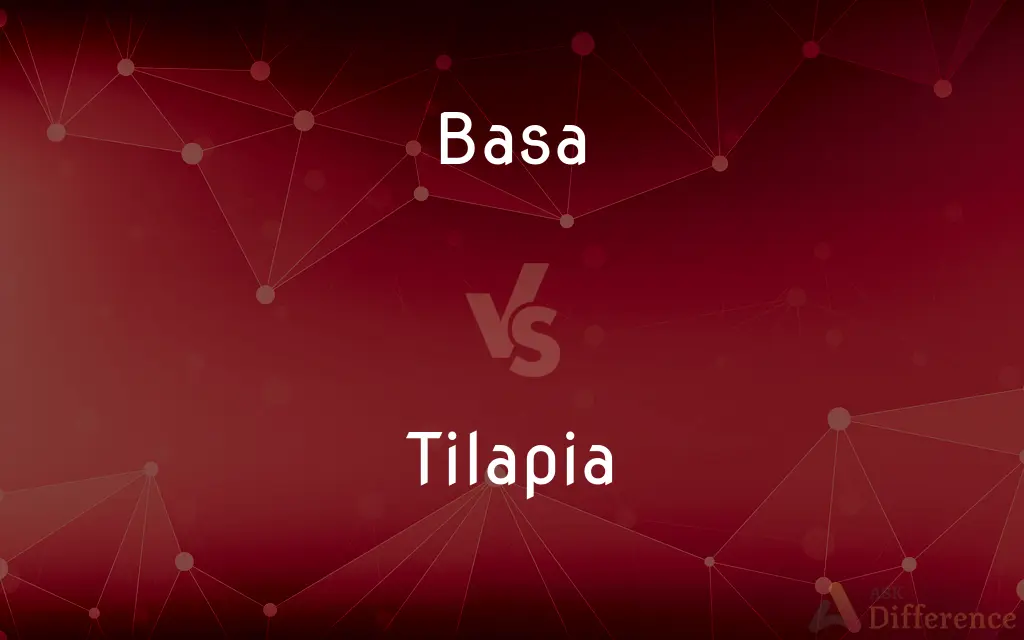Basa vs. Tilapia — What's the Difference?
By Tayyaba Rehman & Fiza Rafique — Updated on March 14, 2024
Basa fish are primarily farmed in Vietnam and known for their mild flavor, while tilapia are widely farmed globally with a slightly firmer texture.

Difference Between Basa and Tilapia
Table of Contents
ADVERTISEMENT
Key Differences
Basa, a type of catfish native to Southeast Asia, is often praised for its smooth texture and mild, sweet flavor, making it a popular choice for various culinary applications. Tilapia, on the other hand, is a freshwater fish that is more widely available and farmed around the world, known for its versatility and slightly firmer texture, which holds up well in a variety of cooking methods.
While basa fillets are typically large, white, and have a delicate taste, they are especially suited for frying or grilling, allowing the fish's subtle flavors to be enhanced by seasoning. Tilapia, whereas, has a stronger flavor than basa and is often praised for its ability to absorb marinades and spices, making it a favorite in flavorful dishes.
In terms of nutritional content, basa is a good source of protein and omega-3 fatty acids, though it has been scrutinized for farming practices in the Mekong Delta, which may affect its quality. Tilapia, on the other hand, is also rich in protein but has garnered attention for its higher levels of omega-6 fatty acids, which could be a concern when consumed in large quantities due to the potential for inflammation.
Sustainability practices vary significantly between basa and tilapia farming. Basa farms, particularly in Vietnam, have faced criticism for environmental impacts, whereas tilapia farming is often touted for its more sustainable practices, as tilapia are hardy fish that can thrive in diverse farming environments.
Despite their differences, both basa and tilapia offer culinary versatility. Basa's mild flavor is ideal for those who prefer a less fishy taste, while tilapia's robustness makes it suitable for a wide range of dishes, from baking to grilling and beyond.
ADVERTISEMENT
Comparison Chart
Origin
Southeast Asia, mainly Vietnam
Widely farmed globally
Texture
Smooth and tender
Slightly firmer
Flavor
Mild and sweet
Stronger, adaptable to marinades
Nutritional Content
High in protein, some omega-3s
High in protein, higher omega-6s
Sustainability
Concerns over farming practices
Generally more sustainable
Compare with Definitions
Basa
Smooth texture.
The tenderness of basa makes it ideal for baking.
Tilapia
Globally farmed freshwater fish.
Tilapia is a staple in diets worldwide, known for its ease of farming.
Basa
Mild and sweet flavor.
Basa fillets are perfect for light, seasoned dishes.
Tilapia
Adapts well to flavors.
Tilapia fillets are great for marinated dishes.
Basa
Farming concerns.
Environmental and quality concerns are associated with basa farming.
Tilapia
Sustainability.
Tilapia farming is considered more sustainable, benefiting environments with its efficient farming methods.
Basa
Southeast Asian catfish.
Basa is popular in Vietnamese cuisine, often served grilled.
Tilapia
Nutritional profile.
Tilapia is a protein-rich option, though it's higher in omega-6 fatty acids.
Basa
Culinary versatility.
Basa is widely used in fish tacos and seafood platters due to its mild flavor.
Tilapia
Slightly firmer texture.
Its firmness makes tilapia suitable for various cooking methods, including grilling.
Basa
A catfish (Pangasius bocourti) native to Southeast Asia, often cultivated in fish farms for food. Also called pangasius.
Tilapia
Tilapia ( tih-LAH-pee-ə) is the common name for nearly a hundred species of cichlid fish from the coelotilapine, coptodonine, heterotilapine, oreochromine, pelmatolapiine, and tilapiine tribes (formerly all were "Tilapiini"), with the economically most important species placed in the Coptodonini and Oreochromini. Tilapia are mainly freshwater fish inhabiting shallow streams, ponds, rivers, and lakes, and less commonly found living in brackish water.
Basa
The catfish Pangasius bocourti.
Tilapia
Any of various cichlid fishes of the genera Tilapia, Oreochromis, and Sarotherodon, native to Africa and the Middle East and raised for food in many parts of the world.
Tilapia
Any of various edible fish, formerly species of the genus Tilapia, but now placed in other cichlid genera (such as Oreochromis), native to Africa and the Middle East but cultivated worldwide.
Tilapia
A genus of Cichlidae
Common Curiosities
Are there sustainability concerns with basa farming?
Yes, basa farming, especially in Vietnam, has faced criticism for its environmental impact.
Which is more nutritious, basa or tilapia?
Both are good protein sources, but basa has omega-3 fatty acids, and tilapia has higher omega-6 levels.
Where is basa primarily farmed?
Basa is primarily farmed in the Mekong Delta region of Vietnam.
What is basa fish?
Basa is a type of catfish native to Southeast Asia, known for its mild flavor and smooth texture.
How do basa and tilapia differ in flavor?
Basa has a mild, sweet flavor, while tilapia has a stronger taste that adapts well to various seasonings.
Why is tilapia considered more sustainable?
Tilapia is hardy and can be farmed efficiently in diverse environments, making it a more sustainable choice.
What makes tilapia popular in cooking?
Its firmer texture and flavor adaptability make tilapia popular for grilling, baking, and marinated dishes.
Can basa and tilapia be used interchangeably in recipes?
Due to their different textures and flavors, they might not be directly interchangeable but can both be used in a variety of dishes.
How does basa's flavor compare to other fish?
Basa's flavor is milder and sweeter compared to many other fish, appealing to those who prefer a less fishy taste.
Can basa be considered a healthy fish option?
Basa can be part of a healthy diet, especially if sourced from responsible farming practices.
What distinguishes tilapia?
Tilapia is a widely farmed freshwater fish valued for its firmer texture and ability to absorb flavors.
What cooking methods suit basa?
Basa is well-suited for frying, grilling, and baking, thanks to its mild flavor and smooth texture.
What are common concerns with tilapia farming?
While considered sustainable, some tilapia farming practices have been scrutinized for potential health impacts due to feed quality.
What are key differences in the culinary use of basa vs. tilapia?
Basa is best for dishes that highlight its mild flavor, while tilapia is versatile, ideal for flavorful preparations.
Is tilapia good for health?
Tilapia is nutritious, offering protein and essential nutrients, though its omega-6 content should be balanced in a diet.
Share Your Discovery

Previous Comparison
Anxiety vs. Agitation
Next Comparison
Aspersorium vs. AspergillumAuthor Spotlight
Written by
Tayyaba RehmanTayyaba Rehman is a distinguished writer, currently serving as a primary contributor to askdifference.com. As a researcher in semantics and etymology, Tayyaba's passion for the complexity of languages and their distinctions has found a perfect home on the platform. Tayyaba delves into the intricacies of language, distinguishing between commonly confused words and phrases, thereby providing clarity for readers worldwide.
Co-written by
Fiza RafiqueFiza Rafique is a skilled content writer at AskDifference.com, where she meticulously refines and enhances written pieces. Drawing from her vast editorial expertise, Fiza ensures clarity, accuracy, and precision in every article. Passionate about language, she continually seeks to elevate the quality of content for readers worldwide.














































